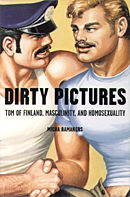|
|
||||||||||||
| Excerpts: | ||||||||||||
|
||||||||||||
| Illustrations: | ||||||||||||
|

Gay/Lesbian/Feminist Bookstores Around the Country
The Mostly Unfabulous Homepage of Ethan Green
![]()

 See Dick Run:
See Dick Run:
The Pornographer and the Culture Brokers
From Dirty Pictures by Micha Ramakers
The route Tom of Finland’s work has traveled over the four decades during which he was active as a draftsman is somewhat surprising. From the physique magazines of the fifties and early exhibitions in sex shops, it moved on to the temples of high culture, ending up in the early nineties on the Whitney Museum’s walls, at Christie’s auctions, and as the subject of reviews in glossy art magazines. This chapter starts out with a brief biographical sketch, moves on to track the itinerary of Tom’s work, and concludes by looking at some of the dangers that lurk in high art’s darker corners.
Touko’s Early Years
Touko Laaksonen, who would become Tom of Finland, was born to teacher parents on May 8, 1920, in the northern-European country of Finland, a densely forested and ardently Evangelical Lutheran land that had gained independence from Russia three years earlier. His family included two older sisters, a brother, and a younger sister. The Laaksonens lived peacefully at the village school of Kaarina, near Turku, of which the village has today become a suburb: "I grew up in a strong family with one brother, three sisters, and lots of cousins always around. We lived outside a small town in western Finland, so my first fantasies were of farmboys and bus drivers who passed on the road. Those guys were different from my schoolteacher father, who always pushed his musical interests on me and wanted me to play the organ." One of the boy’s earliest passions was drawing cartoon stories; at age eight he had started a lifelong infatuation with this format. Before long, his sexuality awoke and founds its way into his pictures: "I made my first sexual drawings when I was ten years old, before I really even knew how to do them. I mean, I knew how people fuck, but not how to guys fuck, so I couldn’t show the action, just tough figures. One day, my younger sister found the drawings in my bureau drawer and got all excited by them, but she didn’t understand them." His interest in art did not diminish during his high school years, and after graduating in 1939 he pursued a degree in commercial drawing at Helsinki’s Art Academy, where he got his first taste of freedom: "I wasn’t interested in sitting in church and playing an organ, so I left home at nineteen to study advertising art in Helsinki. Then came the war – five years of it – and the Nazis."
Touko was drafted in April 1940, which put a temporary halt to his erotic output, and spent most of the war guarding the rather quiet skies over suburban Helsinki. Finland, besieged by the USSR, had been a German ally since 1941, but not until the summer of 1944 did Lieutenant Laaksonen come face-to-face with Soviet troops on the eastern front in the Karelia region.
After the war, Touko participated in a state-sponsored exhibition of art produced by soldiers, contributing some two dozen portraits (which have been missing ever since). He returned to the Art Academy, studying graphic design, and in 1946 he took piano lessons at Helsinki’s Sibelius Academy. From 1948 on he worked as a freelance designed in publicity, doing magazine layouts and window displays, a living he supplemented in the early fifties by playing the piano at Helsinki’s Palace Hotel. Touko was by now well-known on Helsinki’s underground gay scene, but was – as were most homosexuals in those days – very discreet about this sexual preference outside gay circles. At that time homosexuality was illegal (and would continue to be until 1971) and a social taboo in Finland.
The Fifties and Sixties: Beefcake and Beyond
In 1951, in his early thirties, Laaksonen started traveling around Europe and over the following years discovered the budding leather scenes of Berlin, Hamburg (where he bought his first porn in 1951), and London. In these cities he was noticed because of the portfolio of drawings that he always carried with him. His trips did not always go smoothly: "In the early "50s, I was living in Berlin, and I was, well, I was pretty wild. I wouldn’t listen to what anybody said and the upshot was that I had everything stolen from me. Even my passport. Several hundred drawings as well. Then, five years ago, I was in Belgium, and this man asked me if I would like to see several of my old drawings. What does he show me? Nine of the works that were stolen 30 years before and two countries away!" After returning to Helsinki in 1953, he met the man of his life while on one of his cruising bouts. A dancer, Veli (Finnish for "brother"; his surname is not in the public domain) would become his only longtime companion, their relationship lasting until Veli’s death from throat cancer in 1981: "I had actually only one relationship that I would call… a love relationship. I had short-term affairs with a couple of guys before that, but then I met one young guy who was twelve years younger than I was… I met him in 1953 in a park, I was coming home from somewhere and I felt now I had to have some contact with somebody, have a couple drinks or so. So I met this guy on the street, and he was just – he was not hustling – but he was like a hustler, and so I started talking to him and asked him if he wanted to have a drink, and so he was very willing to do that. And so he stayed at my place that night, and we didn’t make any plans for the future, but next night when I came home again he was there waiting… so that’s when it started, and that’s when we moved to my place and we started living together. But it wasn’t easy. We had problems in the beginning very much, and then came the time that the sex wasn’t any more the most important thing but it was deeper inside, but it was on a mental level, different, and the harmony was built there, in a way. I think that still, at least to me, there was more love in that than in the sex we’d had before. The feeling, this love, a real love, a great relationship was grown from there all those years through."
Copyright © 2000 Micha Ramakers.
 Back
to the Stonewall Inn
Back
to the Stonewall Inn
